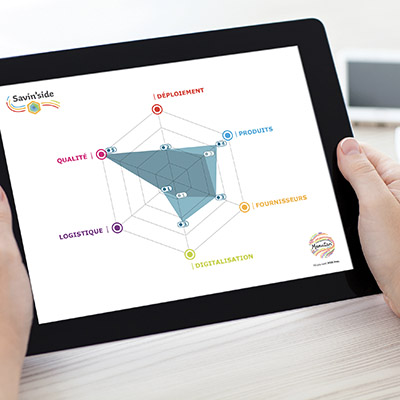Today, organisations have no choice but to integrate environmental and social challenges into their overall strategy. In this dynamic, procurement departments have a prime position to contribute their part to the effort. This involves building a sustainable procurement policy, but also deploying a sustainable procurement charter. This is what enables them to formalise their vision, involve stakeholders and structure this approach over the long term. Therefore, it is up to each organisation to draft a charter that is comprehensive, concrete and realistic.
What is a sustainable procurement charter for?
A sustainable procurement charter aims to share the commitments, requirements and expectations of a company towards its suppliers and subcontractors, thus ensuring their involvement in sustainable development. The idea is to associate suppliers with a continuous improvement approach.
This document establishes a common reference framework for procurement teams and the company's suppliers, by formalising the guidelines for the sustainable procurement approach. Because this provides clarity to all these stakeholders, it promotes the alignment of procurement decisions and value chain operations with its own sustainability considerations.
This charter must, therefore, be signed by suppliers, particularly by all newly listed suppliers. Through such a document, the company reaffirms its desire to move from a simple client/supplier relationship to a genuine partnership.
Marine Varret, Sustainable Development Manager for Offer and Supply Chain at Manutan Group, adds: "For a sustainable procurement charter to be truly effective, it must not be limited to generic principles. Above all, it must be adapted to the environmental, social and ethical challenges specific to the company. It is also important to encourage suppliers to adopt this same approach with their own partners to multiply the impact of the initiative. Finally, formalising commitments is a first step: regular evaluations must then be put in place to measure compliance and accompany suppliers in a logic of continuous improvement."
How to draft your sustainable procurement charter?
A sustainable procurement charter is generally composed of three main parts: the introduction, the context and the commitments expected from suppliers.
The Introduction
The sustainable procurement charter opens with a preamble, which establishes the foundations of the document. This involves explaining that the charter is part of the Corporate Social Responsibility (CSR) strategy framework and specifying the recipients as well as the objectives. This section can be signed by the company's Chief Procurement Officer to embody the message.
The context
Next, it is important to place the sustainable procurement charter in the company's context. It is necessary to explain how this charter contributes to the commitments and sustainable development objectives of the company, but also what its link is with the company's other tools and policies (ethics and/or diversity charter, environmental policy...).
This implies specifying the main challenges of its CSR strategy: reducing the carbon footprint, integrating the circular economy, respecting human rights throughout its supply chain, guaranteeing good working conditions...
Expected commitments from suppliers
Lastly, we arrive at the central part of the document: the commitments that the company expects from its suppliers in terms of sustainable development.
It addresses key themes:
- The environment: reducing greenhouse gas emissions, waste management, efficient use of resources, eco-design...
- Social aspects and human rights: respect for human rights, non-discrimination, the health and safety of people, remuneration, working hours...
- Business ethics and compliance: fighting corruption, transparency, protection of personal data...
Sustainable procurement charter: 3 best practices
To guarantee the success of its sustainable procurement charter, there are several best practices to remember when drafting the document, and even during its deployment.
Involving stakeholders
From the drafting stage, it is important to mobilise the necessary stakeholders: the procurement department, of course, but also the ordering parties, the CSR management and even the main suppliers. Once the charter is in place, training sessions can also be organised to ensure that everyone understands the requirements and their responsibilities. A collaborative and educational approach definitely promotes adherence to this charter.
Opening the way to recommendations
It is also interesting to distinguish what is imperative from what is appreciated. For each theme, we can list the elements that are imperatively required from suppliers, but we can also mention the actions that are encouraged, beyond the basic requirements. For example, we can require our suppliers to prohibit any form of discrimination, but we can also suggest that they be proactive in promoting equal opportunities. This encourages everyone to go even further in their sustainable development approach.
Build on fundamental principles
In its sustainable procurement charter, it is important to specify the reference frameworks and external standards on which the company relies. We can even go so far as to explain the principles for greater clarity.
International Reference Texts
- The ten principles of the United Nations (UN) Global Compact;
- The International Bill of Human Rights;
- The Global Reporting Initiative (GRI);
- The International Labour Organisation (ILO) conventions ;
- The Organisation for Economic Co-operation and Development (OECD) Guidelines for Multinational Enterprises;
- The Coalition for Environmentally Responsible Economies (CERES) principles ;
- The UN Guiding Principles on Business and Human Rights;
- The ISO 26000 standard related to Corporate Social Responsibility;
- The ISO 14001 standard concerning environmental management;
- The ISO 20400 standard relating to sustainable procurement.
In the end, this sustainable procurement charter must be part of a continuous improvement logic. In this sense, it will be regularly updated to integrate feedback from the field and evolve according to the latest regulations and innovations.
In conclusion, the sustainable procurement charter constitutes a strategic transformation lever for any organisation. This reference document promotes the development of a balanced and sustainable relationship as well as risk management, in the service of sustainable growth.









